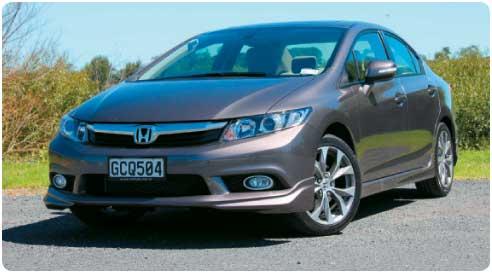Robert Barry drives the latest Honda Civic range and feels that the more conservative styling and better packaging will appeal to fleet buyers.
A more conservative styling approach to the new Honda Civic has produced a pleasant and spacious car that is also much quieter on-road than its predecessor. There are three models available, the 1.8S, 2.0S and Civic IMA (hybrid).
After a brief drive of all three Civic variants around the North Waikato, the 1.8S automatic stood out as best value for a fleet, and certainly of the three it was the most pleasant to drive. It just felt sweeter and livelier than the 2.0S and the IMA versions, and quieter too.
The ninth generation Civic provides a more compliant ride yet retains crisp handling thanks to the reduced wheelbase and overall length of the vehicle, although the exterior width and height remain the same as the outgoing model. In truth the dimensions of this Civic are not that much smaller than the first generation of the Honda Accord Euro.
Notably the interior space has grown with an additional 75mm of shoulder room in the front, an extra 25mm of rear legroom and a four percent increase in overall interior volume. But sadly the hard-to-the-touch plastics and their brown tones on the dashboard and around the audio system reminded me of the interior of my old 1983 Honda Civic. Shouldn’t Honda have moved on by now?
Honda has redeveloped the NP4 engine from the previous generation to provide more power and economy. The 1.8-litre engine produces 104kW and 174Nm of torque, while the 2-litre engine delivers 114kW and 190Nm of torque. There is more power available between 2000-4000rpm, where it’s most needed in day-to-day driving, and the new models certainly feel livelier and more responsive than before.
The IMA engine incorporates variable cylinder management (VCM) for engine shutdown, and Honda’s IMABoost system. IMABoost incorporates a 20kW electric motor in series and gives 172Nm of torque in the main driving range, from start-up to 3500rpm. The all new Li-ion battery enables fast cycling and tuning for power. According to Honda the system gives the Civic IMA similar performance to the 2.0S model.
ADR consumption tests resulted in the Civic IMA achieving 4.4L/100km, the 1.8S Auto 6.7L/100km and the 2.0S 7.5L/100km. All Civics include Honda’s Econ system, which optimises fuel efficiency over speed.
Regenerative braking incorporated into the IMA model recaptures lost energy and stores it for boost assistance from the 20kW electric motor as required. The regenerative braking can vary depending on the severity of braking and the Civic IMA model also includes Auto-Stop for fuel saving.
Honda’s driver coaching programme is also designed to provide fuel savings. By providing a simple visual guide near the speedo, the driver may choose to manage their driving style to reduce fuel costs, green for economical driving or blue for more aggressive driving. This feature may also be deactivated by the user.
The layout of the Civic dashboard features a central shared area and a driver focused zone. The shared area includes the audio and air conditioning controls, the driver’s area displaying the driving interface and a new intelligent-multi-Information-display (i-MID) screen. The driver interface is two levels, with the upper level displaying speed, fuel level and the new i-MID screen. The lower level features the tachometer and other warning lights. The digital speedo sits in the upper zone, in the line of peripheral vision and requires less adjustment in eye focus to read.
The i-MID screen is integrated with the steering wheel switches and central audio controls, so the driver has the ability to control the entertainment and Bluetooth functions of the car at almost eye level. The driver can select audio source, have full control over selection of artist/album/playlist etc. for USB devices, control Bluetooth telephone call receipt and initiation and keep an eye on fuel economy as well.
Bluetooth handsfree linking caters for up to six phones and auto-loads contacts and recent calling data at pairing.
Using the i-MID screen, the driver can choose to call contacts, history, speed dials or even dial a number directly with the system. Caller name or number can be selected as preferred identification. Bluetooth also allows for music streaming on compatible phones without having to connect the device. This can allow passengers to control the music or enable the phone or other device to be left in the luggage.
The Civic has been awarded a 5-star rating by Ancap in recent testing. Honda says it has developed its unique Advanced Compatibility Engineering (ACE) body structure to further optimise crash performance.
ACE is designed to better meet opposing vehicles in a collision situation and better control energy than the traditional structure and this accommodates different sized vehicles at different heights. Crash energy is directed not only under the car, but also directs forces over the roof of the vehicle to better dissipate the crash energy and away from the passenger protection zone.
All Civics come with electronic stability assist (Honda’s VSA), which Honda says was tuned specifically for the vehicles at the Takasu test track in Japan.
This has been upgraded to include Honda’s motion adaptive electric power steering (MA-EPS). The MA-EPS works in addition to VSA and intuitively prompts the driver to steer in the correct direction in an under or over-steer situation by adjusting the EPS to make steering lighter in the correct direction and heavier in the incorrect direction. This intuitively reinforces the correct steering adjustment to keep the vehicle stable. No automatic steering is undertaken for the driver.
A Sport package is available for the Civic 1.8S, 2.0S and IMA at additional cost. Optional leather is also available on the 1.8S and IMA for an additional $3,000.



